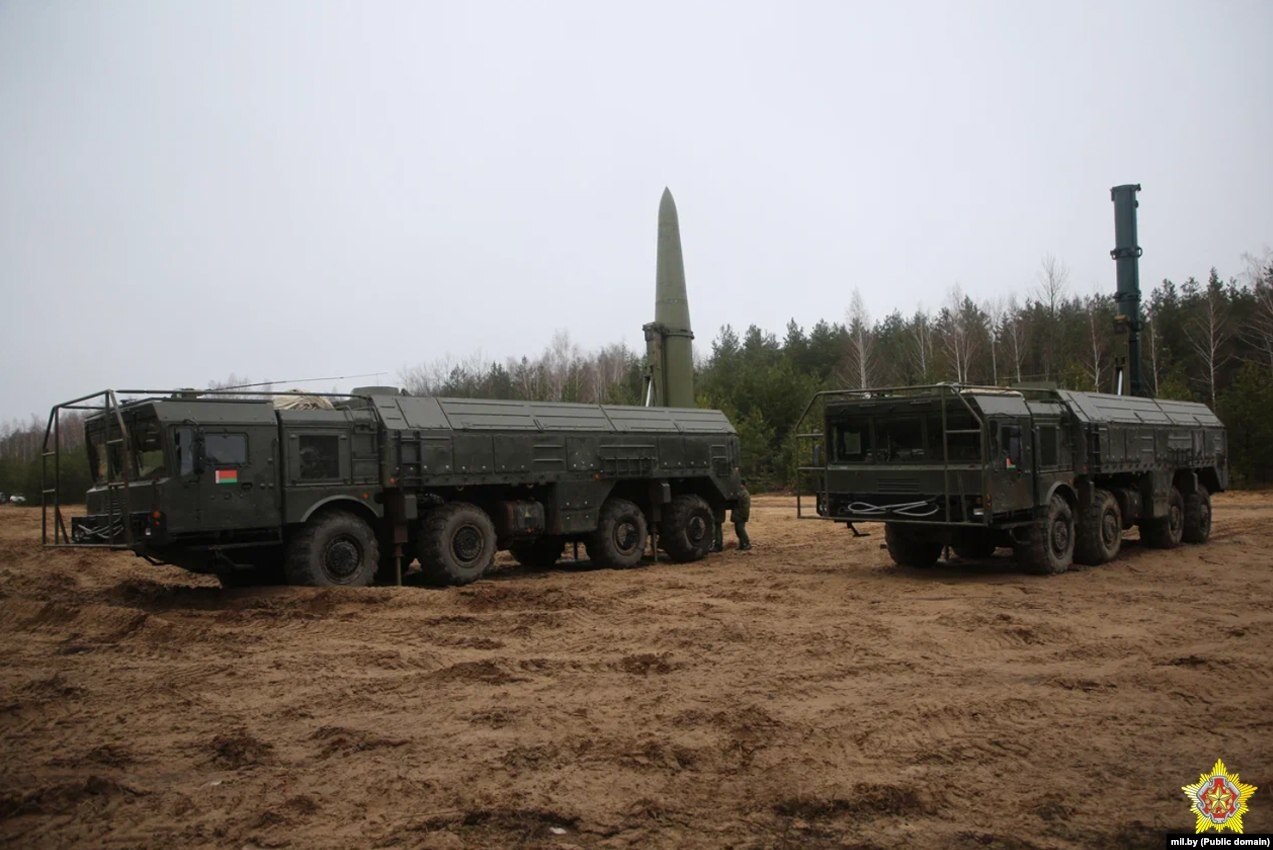
Russia Develops Infrastructure for Operational Use of Tactical Nuclear Weapons from Belarusian Territory
Russia Develops Infrastructure for Operational Use of Tactical Nuclear Weapons from Belarusian Territory
Executive Summary:
- Since 2022, significant military construction has occurred in Asipovichy, Belarus, including new Iskander-M missile systems hangars, ammunition storage, and barracks at Military Unit 61732 (465th Missile Brigade).
- Satellite imagery confirms the near completion of facilities designed to support a new missile brigade with 12 nuclear-capable launchers, indicating growing Russian tactical nuclear weapons (TNW) capabilities in Belarus.
- The nearby 1405th Artillery Ammunition Base (Military Unit 42707)—a suspected TNW warhead storage site—has undergone extensive fortification and modernization. These changes follow Russian President Vladimir Putin’s March 2023 declaration to station TNWs in Belarus.
- A dedicated railway line is under construction to connect the 1405th Base with the 465th Missile Brigade. This will enable 30-minute deployment cycles for nuclear-armed Iskander-М missiles and reflect the establishment of a Repair and Technical Base (RTB) for TNWs and readiness for their operational use from Belarusian territory.
Satellite images indicate significant infrastructure development in Asipovichy, Belarus, where a storage site for Russian tactical nuclear weapons (TNW) may have been established since the beginning of Russia’s full-scale invasion of Ukraine (EDM, May 9, 2024; February 13). This includes the construction and renovation of barracks, ammunition storage facilities, and specialized hangars intended for Iskander-M operational tactical missile systems. A dedicated rail spur is being built to connect these facilities (Svaboda.org, March 24).
Construction of new hangars began in October 2022 at Military Unit 61732 in Asipovichy. The 465th Missile Brigade of the Belarusian Ground Forces, equipped with Iskander-M missile systems, is located here. One hangar was completed in mid-2023, and two more foundations were laid in the fall of 2023. Based on observed layouts, each hangar can accommodate one Iskander division. This confirms the formation of a new missile brigade in Asipovichy with 12 Iskander-M launchers (see EDM, March 13; Svaboda.org, March 24). Satellite imagery confirms that as of February 25, construction there is nearing completion. In addition to the Iskander-M hangars, three buildings for storing vehicles and equipment, a renovated barracks, a warehouse, administrative buildings, and even a sports complex with a football field have been completed since mid-2023 (Svaboda.org, March 24).
In northwest Asipovichy, new multi-story residential buildings and a school are under construction on a former military site. According to BelPol, an association of Belarusian ex-security officials, the Belarusian Armed Forces’ Capital Construction Directorate is behind two housing projects at 32 and 34 Krylovich Street, under a classified Presidential Decree No. 289s, dated September 20, 2023 (Belpol.pro, November 24, 2024). Local authorities confirmed that some of these buildings had been allocated to military personnel from various local units (Osipovichi.gov.by, March 14). Some of the apartments may be redistributed among servicemen of the 12th Main Directorate of the Russian Ministry of Defense, also known as 12th GUMO, which is responsible for dealing with nuclear arsenals. In particular, some reports suggest that approximately 20 Russian personnel have been stationed at the 1405th Artillery Ammunition Base, Military Unit 42707, which is one of the most probable nuclear warhead storage sites and is located 12 kilometers (7.45 miles) from Asipovichy (see EDM, April 30, 2024; Ukrinform.ua, February 19).
Several factors at the 1405th Artillery Ammunition Base indicate preparations for storing nuclear warheads. It has undergone extensive redevelopment, particularly in its northern section, where forest has been cleared, three-tiered fencing is now installed, and new buildings and communication towers have been erected. The expansion of construction coincided with Russian President Vladimir Putin’s announcement on March 25, 2023, about plans to station TNW in Belarus, with storage completion initially scheduled for July 1, 2023 (Interfax, March 25, 2023). Since spring 2023, several administrative and barracks buildings have been constructed or renovated in the western section of the 1405th base. Belarusian government procurement data confirm ongoing contracts since February 2023 for refurbishing barracks, guardhouses, warehouses, vehicle bays, and other facilities. The new barracks would allow for an expanded garrison of up to 240 personnel.
Since June 2023, two earthen mounds for air defense systems have been constructed, exceeding the height of nearby barracks. Tenders indicate purchases of concrete, rebar, fencing, electrical materials, and two 25-meter lightning rods. A “Relief-2” perimeter security system, used at high-risk sites such as nuclear power plants and military bases, was also procured. An SRK-AT2327 radiation indicator produced by Belarusian firm Atomtech has also been installed on a refurbished headquarters building. These indicators are typically installed at nuclear-sensitive sites. Since 2020, only the 8th Radiation, Chemical and Biological Protection (RChBZ) Brigade and Unit 7434 (guarding the Astravets Nuclear Power Plant) have acquired them (Svaboda.org, March 24).
A dedicated railway line is being built to connect the 1405th Artillery Munitions Base to the city of Asipovichy and the Iskander-M deployment site, the 465th Missile Brigade. Construction began in late summer 2024, but procurement documents reveal that the railway had been planned since at least 2020 as part of a Union State military infrastructure program approved by the Union State Council of Ministers in December 2017 (Decree No. 46) (Radio Free Europe/Radio Liberty, March 24). The project, executed by TransSoyuzProject, includes track construction from Garozha station to the base; four open and closed loading platforms; two electric hoists (hanger cranes) with a lifting capacity of 3.2 tons each and a lifting height of 6 meters each; entry/exit gates with external/internal fencing; service area 600 meters from the base; guardroom for 8 personnel; radio, CCTV, and alarm systems; and full utility infrastructure. With a launch weight of 3.8 tons for the operational-tactical missiles of the Iskander-M system, these cranes, with a combined lifting capacity of 6.4 tons, are clearly intended for their loading and unloading. A revised timeline by Colonel Alexander Budyankov, head of the construction department, rescheduled completion from 2023 to 2024, using off-budget funds from the Belarusian Defense Ministry (Belpol.pro, December 7, 2024).
The railway construction plans also include the creation of an “iodine prophylaxis zone” in the village of Malaya Garozha near the 1405th Artillery Munitions Base, another indicator of the potential presence of nuclear weapons at the base (Svaboda.org, March 24). Iodine is used during nuclear and radiological emergencies to protect the thyroid from radiation poisoning (World Health Organization, July 7, 2023). Officially, Asipovichy itself is not within the pre-defined 100-kilometer (62-mile) emergency zones around Astravets, Ignalina, Chornobyl, Rivne, and Smolensk nuclear power plants. The iodine prophylaxis site near the base is unusual—typically associated only with “special” locations where a nuclear explosion might occur (Pravo.by, October 19, 2022).
Russian forces are creating not a Central Storage Facility designed for long-term safekeeping but a Repair and Maintenance Base (RTB) for TNW on the territory of the 1405th Artillery Ammunition Base, serving as an element of operational preparations for their combat use (EDM, April 30, 2024). The construction of a separate railway line between the ammunition base and the Iskander-M missile systems dislocation indicates preparations for the operational use of TNW within 30 minutes after receiving the order from General Staff of the Russian Armed Forces/Joint Command of the Regional Troops Grouping of Belarus and Russia (see EDM, August 15, 2024). In such a scenario, personnel of the 12th Main Directorate of the Russian Ministry of Defense mount tactical nuclear warheads on missiles stored at the 1405th Artillery Ammunition Base. Next, missiles would be transported by rail in special wagons to the positions of Iskander-M missile systems at the 465th Missile Brigade. Before rail transportation or at this stage, Russian personnel activate the permissive action link of tactical nuclear warheads with a chain of special codes (see EDM, February 13). Together with Belarusian servicemen, Russian forces would load missiles onto transport-loading vehicles from Iskander-M missile systems, which would then load them into launchers at combat positions later.
In total, the combination of the expansion of military infrastructure in Asipovichy, construction of dedicated storage and housing for TNW-capable systems and warheads, development of rail logistics, security perimeter, air defense, and radiation safety infrastructure suggests that Russia and Belarus are building the capability for rapid, operational use of Russian TNW from the Belarusian territory. The enhanced presence of Russian TNW at Asipovichy indicates that Belarus has transformed into a forward-deployed nuclear launch platform at Ukraine and the North Atlantic Treaty Organization’s doorstep.

